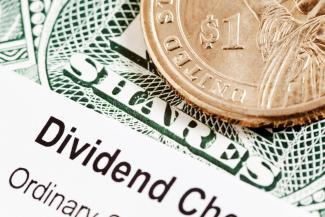
The Key to Dividend-Paying Stocks
Investors traditionally have had an appetite for yield. Sitting back and collecting a quarterly payment from doing nothing more than making an initial investment is attractive, especially to retirees or those depending on a consistent stream of cash flow. Dividend investing not only offers a source of income, but has the potential to provide strong, long-term returns, making it a compelling strategy for a range of investor types.
Selecting a high-dividend strategy typically means that investors are looking for more yield than otherwise obtainable by investing in the broad market index. The S&P 500 ETF (SPY), for example, has a 12-month yield of close to 1.38% but has averaged more than 3% since 1950. Approximately 80% of the S&P 500 Index companies pay a dividend, with a large portion of the index’s total return attributed to dividends. Hence, even with plain-vanilla market exposure, investors can thank dividends for playing a large role in benchmark returns. Moreover, purposefully targeting high-yielding or dividend-growing stocks offers both total return prospects and portfolio stability, leading to stronger risk-adjusted returns. High-yielding stocks have outperformed low-dividend-paying stocks in many time periods, including volatile ones such as during the tech bubble of 1999-2000. But this comes with a caveat: Not all high-yielding stocks are created equal.
Imagine an investor who has purchased General Electric (GE), one of the largest US firms and, for a long-time, a darling of the Dow Jones Industrial Average index. For the past ten years, that investor has collected a steady and generally increasing dividend payment, until 2017-2018, when GE began cutting its quarterly payment to shareholders. In those two years, the stock declined a combined 96%, vastly underperforming the Industrials sector. The investor who has held on is now receiving just $0.01 a share from GE. Though rare, dividend cuts can devastate returns and interrupt the investor’s valued cash flow.
Avoiding companies primed to reduce their dividend policies and targeting companies positioned to maintain or increase their payments is one strategy for investing successfully in high-yielding stocks. The quality factor, which is the tendency for higher-quality companies to outperform lower-quality companies, provides a sound framework. The factor examines a company’s profitability, growth, and leverage to identify well-managed businesses with strong balance sheets that are likely to continue to make payments to shareholders.
Time and again, researchers have found that financially sound firms, measured by the quality factor, have outperformed. A study from 1964-2014 examined the top 100 high-yielding, high-profitability companies, versus the bottom 100 companies with high yields but low profitability. The companies in the top 100 not only averaged an annualized return of 12.80%, with significantly less volatility, but also had subsequent five-year dividend growth rates of 18.60% vs. 10.50% for their high-yielding but less profitable peers. Applying some of the quality metrics in revisiting the GE example above shows profitability declined and leverage increased in the years leading up to the dividend cut, signaling trouble for the firm and re-enforcing the power of the quality factor.
The persistent low-yielding environment has investors searching for income. A high-dividend strategy, with an eye toward avoiding the “falling knives” of companies with deteriorating profitability, can potentially complement a well-diversified portfolio.
If you are interested in learning more about ESG strategies and how your investments can make a social impact, our team at Blue Water Capital Management is here to guide you. Contact us today!
Source: Morningstar, Inc.
Source: Research Affiliates, LLC

